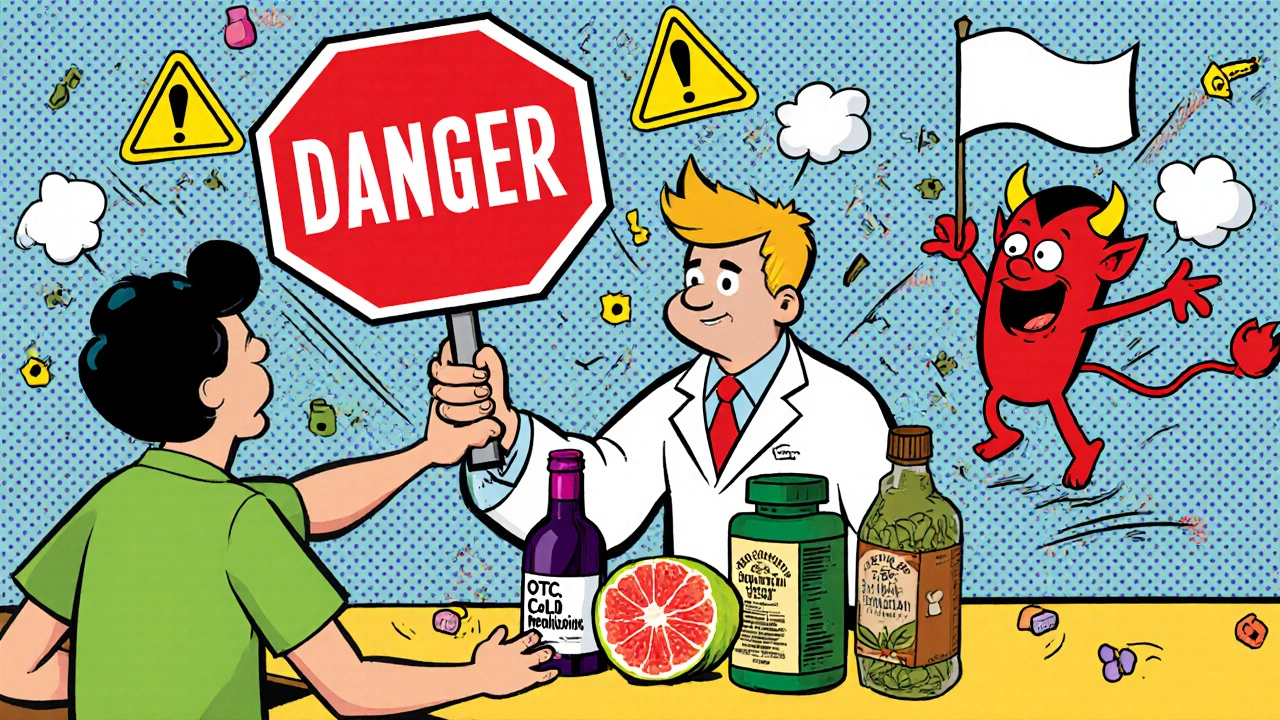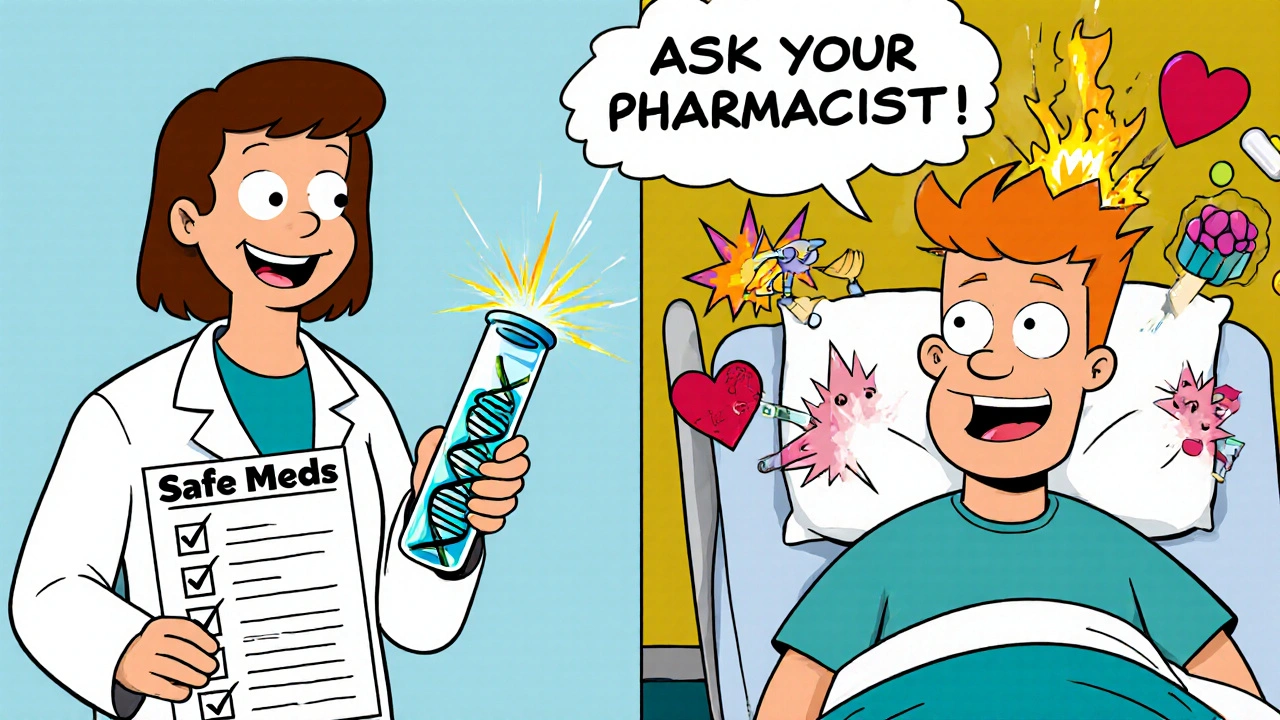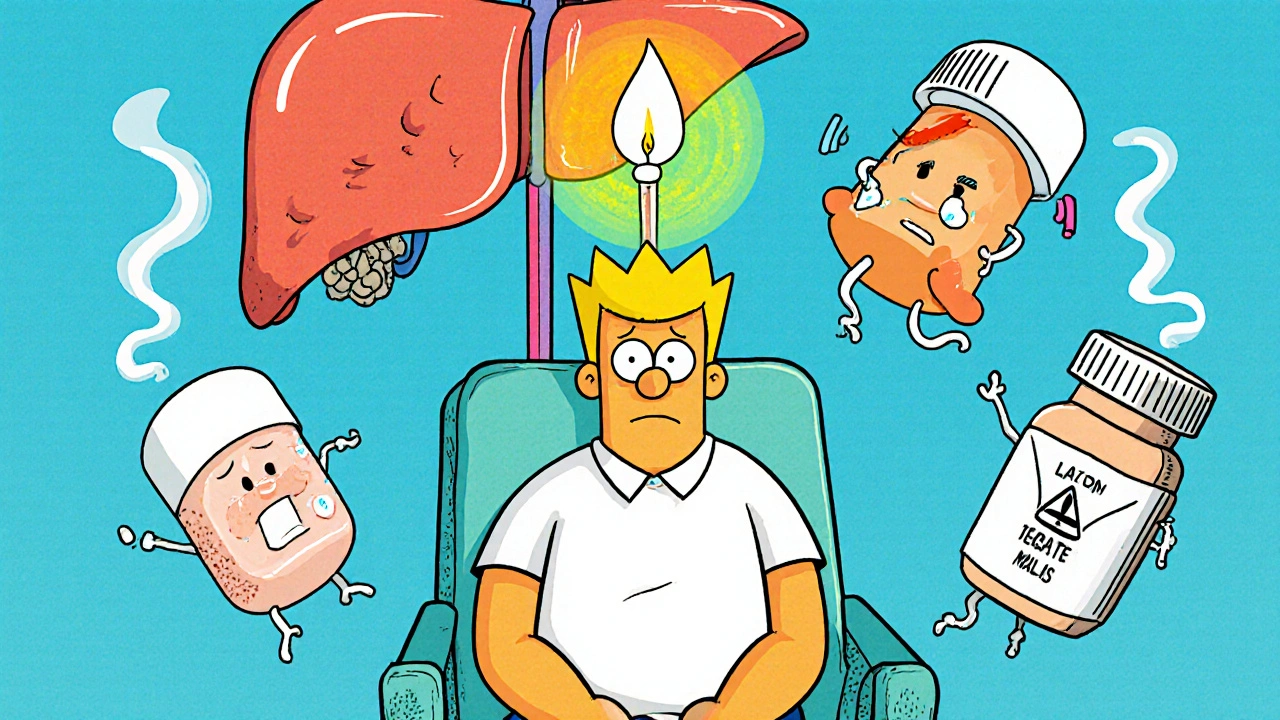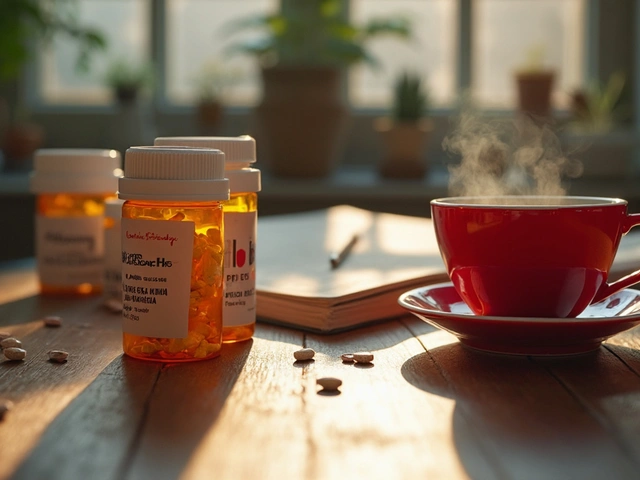When you’re taking more than one psychiatric medication, it’s not just about whether each drug works on its own-it’s about what happens when they meet inside your body. Some combinations can be safe and even helpful. Others? They can land you in the emergency room. The truth is, psychiatric drug interactions are one of the most under-discussed but life-threatening risks in mental health care. And it’s not just about pills. Alcohol, over-the-counter cold meds, herbal supplements, and even certain foods can turn a stable treatment plan into a medical emergency.
How These Interactions Actually Happen
Psychiatric medications don’t float around your body doing nothing. They’re active players in your brain chemistry, mostly targeting three key systems: serotonin, norepinephrine, and dopamine. Each class of drug affects these systems differently. SSRIs like fluoxetine and sertraline crank up serotonin. SNRIs like venlafaxine do that too, but also boost norepinephrine. Antipsychotics like risperidone block dopamine. MAO inhibitors like phenelzine stop your body from breaking down all three neurotransmitters at once. The real danger comes when two or more drugs hit the same system too hard. Take serotonin, for example. Too much of it can trigger serotonin syndrome-a condition that causes high fever, rapid heart rate, muscle rigidity, confusion, and seizures. In severe cases, it kills. And it doesn’t take much to get there. Combining an SSRI with an MAO inhibitor is like pouring gasoline on a fire. Even mixing an SSRI with tramadol, a common painkiller, can push you over the edge. Then there’s the liver. Most psychiatric drugs are broken down by enzymes called CYP450. Some drugs, like fluvoxamine, are strong inhibitors of these enzymes. That means they slow down how fast your body clears other drugs. If you’re on warfarin for blood thinning and start fluvoxamine, your INR can spike 20-30% in days. That’s a bleeding risk. Same thing with lithium. If you take an NSAID like ibuprofen while on lithium, your kidney’s ability to clear it drops. Lithium levels can jump 25-50%. At levels above 1.2 mmol/L, you’re in danger of toxicity-tremors, vomiting, confusion, even coma.High-Risk Combinations You Can’t Ignore
Not all drug pairs are equally dangerous. Some are red flags you should never ignore.- MAO inhibitors + SSRIs/SNRIs/Tramadol/Oxycodone: This is the classic serotonin syndrome combo. Even with a washout period, the risk stays high. If you’re switching from an MAOI to an SSRI, you need at least 14 days between them. No exceptions.
- TCAs + Antihistamines (like diphenhydramine) or Alcohol: Tricyclic antidepressants already cause drowsiness, dry mouth, and blurry vision. Add antihistamines or booze, and you’re looking at severe sedation, low blood pressure, or even respiratory depression.
- Lithium + NSAIDs or Diuretics: Ibuprofen, naproxen, or hydrochlorothiazide can all cause lithium to build up. If you’re on lithium, avoid NSAIDs unless your doctor monitors your levels weekly during the first month.
- Quetiapine + CYP3A4 inhibitors (like ketoconazole or grapefruit juice): Quetiapine is usually low-risk, but when its metabolism is blocked, levels can skyrocket. That means extreme drowsiness, low blood pressure, or heart rhythm problems.
- Clozapine + CYP1A2 inhibitors (like fluvoxamine or ciprofloxacin): Clozapine has a narrow safety window. Fluvoxamine can double clozapine levels. That’s not just risky-it’s potentially fatal without close monitoring.
Why New Combinations Are the Biggest Risk
The moment you add a new drug to your regimen is when things get most dangerous. That’s not because the drugs themselves are evil-it’s because your body hasn’t adjusted yet. Your liver hasn’t caught up. Your brain hasn’t stabilized. That’s why experts recommend first-dose monitoring: stay in the clinic or hospital for 2-4 hours after the first dose of a new interacting combination. Watch for signs like agitation, sweating, fast heartbeat, or shaking. The first 7-10 days after starting a new medication are the most critical. That’s when most adverse events happen. A 2023 U.S. Pharmacist review found that nearly half of all psychiatric drug-related ER visits occurred within this window. It’s not enough to just get the prescription and go home. You need follow-up. A call from your pharmacist. A check-in with your psychiatrist. A blood test if you’re on lithium, clozapine, or valproate.
What Doctors Should Be Doing
Good psychiatric care isn’t just about prescribing-it’s about managing risk. The American Association of Psychiatric Pharmacists (AAPP) says every patient on multiple psych meds needs a structured plan:- Use interaction checkers: Don’t rely on memory. Use tools like Lexicomp or Micromedex every time you add a new drug.
- Choose low-interaction drugs when possible: Sertraline and citalopram have fewer enzyme interactions than fluvoxamine or paroxetine. Venlafaxine is cleaner than TCAs. Quetiapine is safer than risperidone in polypharmacy.
- Monitor with scales: Use PHQ-9 for depression, GAD-7 for anxiety, and AIMS for movement side effects. Track symptoms and side effects side-by-side.
- Test when needed: Genetic testing for CYP2D6 and CYP2C19 can show if you’re a slow or fast metabolizer. That tells you if you’ll need lower doses or avoid certain drugs entirely.
- Document everything: Baseline levels. Monitoring schedule. Action thresholds. If lithium hits 1.2 mmol/L, what’s the next step? Write it down. Share it with the whole care team.
What You Can Do to Stay Safe
You’re not powerless in this. You’re the one who takes the pills every day. You’re the one who knows what’s going on in your body.- Keep a full list: Write down every medication, supplement, and OTC drug you take-even melatonin or St. John’s Wort. Bring it to every appointment.
- Ask: “What happens if I take this with my other meds?” Don’t assume your doctor knows every interaction. Ask specifically about your current list.
- Never mix alcohol with psychiatric meds. It doesn’t just make you sleepy. It can amplify sedation, lower seizure threshold, and worsen depression.
- Know your warning signs: If you feel unusually hot, shaky, confused, or your heart races after starting a new drug-stop and call your doctor. Don’t wait.
- Use digital tools: Apps like Medisafe or MyTherapy can alert you to potential interactions and remind you to take your meds on time. Some even flag dangerous combos.

The Future Is Personalized
The days of guessing which drug combo will work are fading. In 2024, pilot programs from the National Institute of Mental Health started testing AI models that predict your personal interaction risk. These tools look at your genetics, your current meds, your liver function, even your diet. They don’t just say “avoid this combo.” They say, “Based on your CYP2D6 slow metabolizer status, fluoxetine increases your risk of QT prolongation by 68%-consider sertraline instead.” Pharmacogenomics isn’t science fiction anymore. It’s in clinics in Birmingham, London, and beyond. If your doctor hasn’t mentioned genetic testing yet, ask. It’s not expensive. It’s not invasive. And it could save your life.Can I take over-the-counter cold medicine with my antidepressant?
Some can be dangerous. Decongestants like pseudoephedrine can raise blood pressure when taken with MAO inhibitors or SNRIs. Antihistamines like diphenhydramine (Benadryl) can cause dangerous sedation with TCAs or quetiapine. Always check with your pharmacist before taking any OTC medicine. Look for products labeled “non-drowsy” or “low-interaction,” and avoid anything with dextromethorphan-it can trigger serotonin syndrome with SSRIs.
Is it safe to drink alcohol while on psychiatric medication?
No. Alcohol increases sedation, worsens depression and anxiety long-term, and can interfere with how your liver processes meds. With MAO inhibitors, it can cause dangerous spikes in blood pressure. With benzodiazepines or sleep aids, it can stop your breathing. Even one drink can tip the balance. If you’re on psychiatric meds, the safest choice is no alcohol.
How do I know if I’m having serotonin syndrome?
Symptoms usually show up within hours of a new drug or dose change. Look for: shivering, sweating, high fever, fast heartbeat, muscle stiffness (especially in legs), confusion, agitation, or diarrhea. If you have three or more of these, get help immediately. Serotonin syndrome can kill in under 24 hours if untreated. Don’t wait to see if it gets better.
Why do some antidepressants have more interactions than others?
It’s about how they’re broken down. Fluvoxamine blocks multiple liver enzymes (CYP1A2, 2C19, 3A4), so it slows down the clearance of many other drugs. Sertraline and citalopram barely touch those enzymes, so they’re safer in combo therapy. Also, some drugs like MAO inhibitors affect neurotransmitters in ways that are hard to reverse-making them high-risk no matter what you pair them with.
Should I get genetic testing before starting psychiatric meds?
It’s not required, but it’s smart-if you’ve had bad reactions before, or if you’re on multiple meds. Testing for CYP2D6 and CYP2C19 tells your doctor if you’re a slow, normal, or fast metabolizer. Slow metabolizers need lower doses. Fast metabolizers may need higher ones. This can prevent side effects and help pick the right drug from the start. Many insurance plans now cover it.




